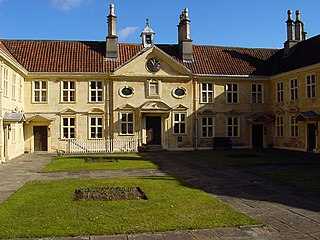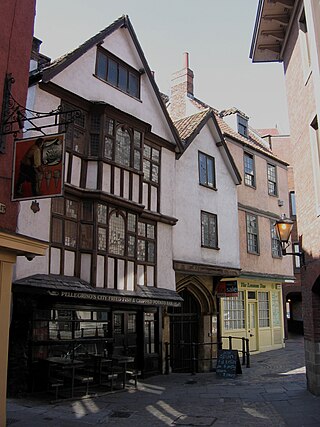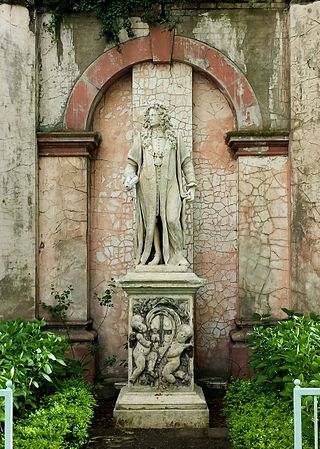
The Church of St Mary the Virgin, widely known as St Mary Redcliffe, is the main Church of England parish church for the Redcliffe district of the city of Bristol, England. The first reference to a church on the site appears in 1158, with the present building dating from 1185 to 1872. The church is considered one of the country's finest and largest parish churches as well as an outstanding example of English Gothic architecture. The church is so large it is sometimes mistaken for Bristol Cathedral by tourists. The building has Grade I listed status, the highest possible category, by Historic England.

Bristol Cathedral, formally the Cathedral Church of the Holy and Undivided Trinity, is a Church of England cathedral in the city of Bristol, England. It is the seat of the Bishop of Bristol. The cathedral was originally an abbey dedicated to St Augustine, founded in 1140 and consecrated in 1148. It became the cathedral of the new diocese of Bristol in 1542, after the dissolution of the monasteries. It is a Grade I listed building.

Edward Colston was an English merchant, slave trader, philanthropist, and Tory Member of Parliament.

Blaise Castle is a folly built in 1766 near Henbury in Bristol, England. The castle sits within the Blaise Castle Estate, which also includes Blaise Castle House, a Grade II* listed 18th-century mansion house. The folly castle is also Grade II* listed and ancillary buildings including the orangery and dairy also have listings. Along with Blaise Hamlet, a group of nine small cottages around a green built in 1811 for retired employees, and various subsidiary buildings, the parkland is listed Grade II* on the Register of Historic Parks and Gardens of special historic interest in England.

St Mary le Port is a ruined parish church in the centre of Bristol, England, situated in Castle Park on what remains of Mary le Port Street.

Bristol, the largest city in South West England, has an eclectic combination of architectural styles, ranging from the medieval to 20th century brutalism and beyond. During the mid-19th century, Bristol Byzantine, an architectural style unique to the city, was developed, and several examples have survived.

There are 100 Grade I listed buildings in Bristol, England according to Bristol City Council. The register includes many structures which for convenience are grouped together in the list below.

The Church of St John the Baptist in Bristol, also known as St John on the Wall, is a historic church in the care of heritage charity the Churches Conservation Trust. The upper church and its medieval vaulted crypt is located at the lower end of Broad Street and is built into the old city's medieval walls.

Colstons Almshouses is a historic building on St Michaels Hill, Bristol, England. It was built in 1691 and has been designated by Historic England as a Grade I listed building. The front wall and gates are also Grade I listed. They are named after the Bristol-born merchant, philanthropist, slave trader, and Member of Parliament Edward Colston.
There are 212 Grade II* listed buildings in Bristol, England.
There are many Grade II listed buildings in Bristol, United Kingdom.

St Mary on the Quay is a Roman Catholic Parish church in Bristol, England. It is situated on Colston Avenue, next to Beacon Tower in the centre of the city. It is the oldest Roman Catholic church in Bristol; the first one built after the Reformation. it was formerly administered by the Society of Jesus and is currently served by the Divine Word Missionaries. It is a Grade II* listed building.

St Bartholomew's Hospital is the site of a medieval monastery hospital at the bottom of Christmas Steps, in Lewin's Mead, Bristol, England. It has been designated as a grade II* listed building.

Foster's Almshouse is a historic building on Colston Street, Bristol, England. The almshouse was founded by a bequest from the 15th-century merchant John Foster in 1492; his will can be read online.

The Centre is a public open space in the central area of Bristol, England, created by covering over the River Frome. The northern end of The Centre, known as Magpie Park, is skirted on its western edge by Colston Avenue; the southern end is a larger paved area bounded by St Augustine's Parade to the west, Broad Quay the east, and St Augustine's Reach to the south, and bisected by the 2016 extension of Baldwin Street. The Centre is managed by Bristol City Council.

The statue of Robert Clayton stands at the entrance to the North Wing of St Thomas' Hospital, Lambeth, London. The sculptor was Grinling Gibbons, and the statue was executed around 1700–1714. Sir Robert was a banker, politician and Lord Mayor of London. As President of St Thomas', he was responsible for the complete rebuilding of the hospital, and associated church in the late 17th century. The statue was designated a Grade I listed structure in 1979.
John Foster, was an English architect and partner in the architectural practice of Foster & Wood of Park Street, Bristol who designed a number of well known buildings erected in Bristol in the 19th century. "It must sometimes seem that the whole of 19th-century Bristol, or at least all of its significant buildings, owed their design to the firm of Foster and Wood".

The statue of Edward Colston is a bronze statue of Bristol-born merchant and trans-Atlantic slave trader Edward Colston (1636–1721). It was created in 1895 by the Irish sculptor John Cassidy and was formerly situated on a plinth of Portland stone in a public space known as "The Centre" in Bristol, until it was toppled by anti-racism protestors in 2020.















